light TOYOTA AYGO 2012 (in English) Manual Online
[x] Cancel search | Manufacturer: TOYOTA, Model Year: 2012, Model line: AYGO, Model: TOYOTA AYGO 2012Pages: 368, PDF Size: 16.94 MB
Page 314 of 368

314 5-2. Steps to take in an emergency
AYGO_WE_99E96EThe following warning indicates the possibility of damage to the
vehicle that may lead to an accident. Immediately stop the vehicle
in a safe place and take the specified steps to correct the sus-
pected problem.
Immediately stop the vehicle in a safe place and take the specified
steps to correct the suspected problem.
Warning lightWarning light/DetailsCorrection procedure
(Comes on)
(If equipped)Multi-mode manual trans-
mission warning light
Indicates a malfunction in
the multi-mode manual
transmission system. Have the system checked
by any authorized Toyota
dealer or repairer, or
another duly qualified and
equipped professional.
Multi-mode manual trans-
mission warning light
(warning buzzer)
Indicates a malfunction in
the multi-mode manual
transmission system and
that the clutch has become
hot due to excessive load. Pull over and shift the shift
lever to N. Wait for about 15
minutes for the clutch to
cool down. Have the system
checked by any authorized
Toyota dealer or repairer, or
another duly qualified and
equipped professional.
Warning lightWarning light/DetailsCorrection procedure
(Flashes)
(If equipped)Heat clutch warning light
(warning buzzer)
Indicates that the clutch
has become hot, but does
not indicate a malfunction
in the multi-mode manual
transmission system.Pull over and shift the shift
lever to N. Wait for about 15
minutes for the clutch to
cool down.
Page 315 of 368
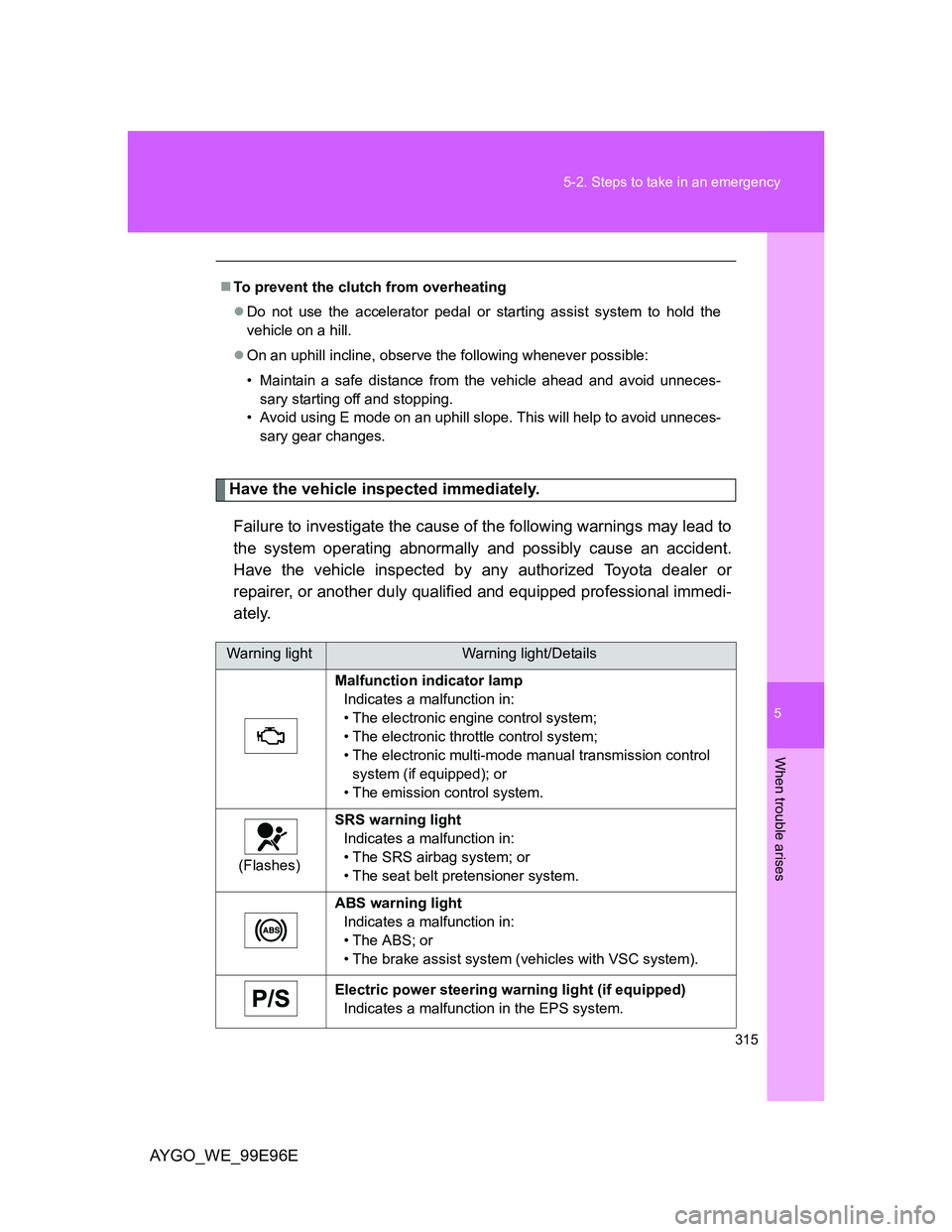
5
315 5-2. Steps to take in an emergency
When trouble arises
AYGO_WE_99E96E
Have the vehicle inspected immediately.
Failure to investigate the cause of the following warnings may lead to
the system operating abnormally and possibly cause an accident.
Have the vehicle inspected by any authorized Toyota dealer or
repairer, or another duly qualified and equipped professional immedi-
ately.
To prevent the clutch from overheating
Do not use the accelerator pedal or starting assist system to hold the
vehicle on a hill.
On an uphill incline, observe the following whenever possible:
• Maintain a safe distance from the vehicle ahead and avoid unneces-
sary starting off and stopping.
• Avoid using E mode on an uphill slope. This will help to avoid unneces-
sary gear changes.
Warning lightWarning light/Details
Malfunction indicator lamp
Indicates a malfunction in:
• The electronic engine control system;
• The electronic throttle control system;
• The electronic multi-mode manual transmission control
system (if equipped); or
• The emission control system.
(Flashes)SRS warning light
Indicates a malfunction in:
• The SRS airbag system; or
• The seat belt pretensioner system.
ABS warning light
Indicates a malfunction in:
• The ABS; or
• The brake assist system (vehicles with VSC system).
Electric power steering warning light (if equipped)
Indicates a malfunction in the EPS system.
Page 316 of 368

316 5-2. Steps to take in an emergency
AYGO_WE_99E96E
Follow the correction procedures.
After taking the specified steps to correct the suspected problem,
check that the warning light goes off.
“VSC” warning light (if equipped)
Indicates a malfunction in:
• The VSC system; or
• The TRC system.
Warning lightWarning light/DetailsCorrection procedure
Low fuel level warning
light (warning buzzer)
Flashes: Indicates that
remaining fuel is about 5.25
L (1.4 gal., 1.1 Imp.gal.) or
less.
Flashes fast: Indicates that
remaining fuel is about 3.5
L (0.9 gal., 0.7 lmp.gal.) or
less.Refuel the vehicle.
Driver’s seat belt
reminder light (warning
buzzer)
*1,*2
Warns the driver to fasten
his or her seat belt.Fasten the seat belt.
Front passenger’s seat
belt reminder light (warn-
ing buzzer)
*2 (if equipped)
Warns the front passen-
ger to fasten his or her
seat belt.Fasten the seat belt.
Warning lightWarning light/Details
Page 317 of 368

5
317 5-2. Steps to take in an emergency
When trouble arises
AYGO_WE_99E96E
*1: Driver’s seat belt reminder:
The driver’s seat belt buzzer sounds to alert the driver that his or her seat
belt is not fastened. The buzzer sounds for 30 seconds after the vehicle has
reached a speed of at least 20 km/h (12 mph). Then, if the seat belt is still
unfastened, the buzzer will sound in a different tone for 90 more seconds.
*2: Driver’s and front passenger’s seat belt reminders:
The driver’s and front passenger’s seat belt buzzer sounds to alert the
driver and/or front passenger that their seat belts are not fastened. The
buzzer sounds for 30 seconds after the vehicle has reached a speed of at
least 20 km/h (12 mph). Then, if the seat belt is still unfastened, the buzzer
will sound in a different tone for 90 more seconds.
Front passenger detection sensor and front passenger seat belt
reminder
If luggage is placed on the front passenger seat, the front passenger
detection sensor may cause the warning light to flash even if a front pas-
senger is not sitting in the seat.
If a cushion is placed on the seat, the sensor may not detect a front pas-
senger, and the warning light may not operate properly.
Electric power steering system warning light
When the battery charge becomes insufficient or the voltage temporarily
drops, the electric power steering system warning light may come on.
If the malfunction indicator lamp comes on while driving
For some models, the malfunction indicator lamp will come on if the fuel tank
becomes completely empty. If the fuel tank is empty, refuel the vehicle
immediately. The malfunction indicator lamp will go off after several trips.
If the malfunction indicator lamp does not go off, contact any authorized
Toyota dealer or repairer, or another duly qualified and equipped
professional, as soon as possible.
CAUTION
When the electric power steering system warning light comes on
The steering wheel may become extremely heavy.
If the steering wheel becomes heavier than usual when operating, hold
firmly and operate using more force than usual.
Page 322 of 368

322 5-2. Steps to take in an emergency
AYGO_WE_99E96ESlightly loosen the wheel bolts
(one turn).
Turn the tire jack handle until the
notch of the jack is in contact
with the jack point.
Raise the vehicle until the tire is
slightly raised off the ground.
Remove all the wheel bolts and
the tire.
When resting the tire on the
ground, place the tire so that the
wheel design faces up to avoid
scratching the wheel surface.
Page 329 of 368
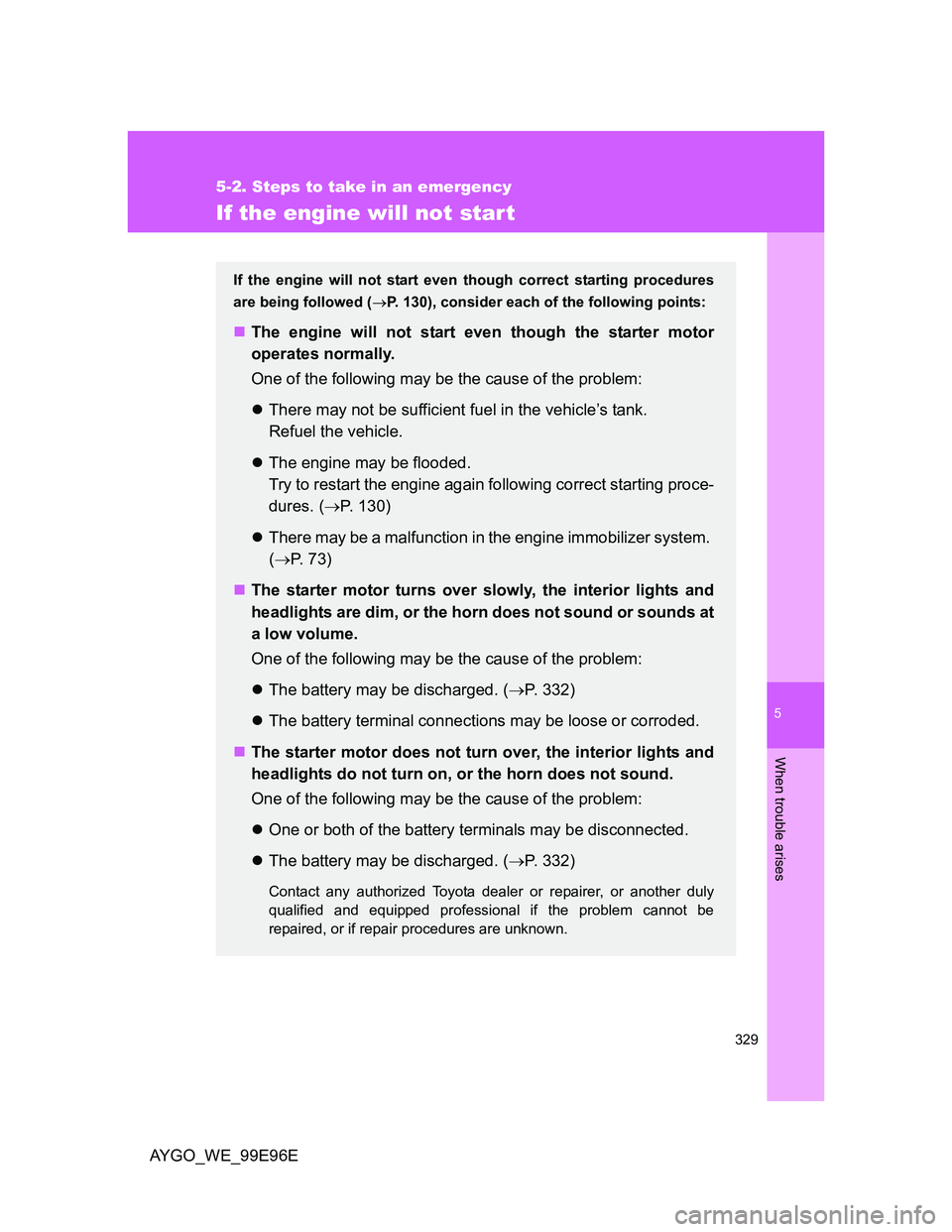
5
329
5-2. Steps to take in an emergency
When trouble arises
AYGO_WE_99E96E
If the engine will not start
If the engine will not start even though correct starting procedures
are being followed (P. 130), consider each of the following points:
The engine will not start even though the starter motor
operates normally.
One of the following may be the cause of the problem:
There may not be sufficient fuel in the vehicle’s tank.
Refuel the vehicle.
The engine may be flooded.
Try to restart the engine again following correct starting proce-
dures. (P. 130)
There may be a malfunction in the engine immobilizer system.
(P. 7 3 )
The starter motor turns over slowly, the interior lights and
headlights are dim, or the horn does not sound or sounds at
a low volume.
One of the following may be the cause of the problem:
The battery may be discharged. (P. 332)
The battery terminal connections may be loose or corroded.
The starter motor does not turn over, the interior lights and
headlights do not turn on, or the horn does not sound.
One of the following may be the cause of the problem:
One or both of the battery terminals may be disconnected.
The battery may be discharged. (P. 332)
Contact any authorized Toyota dealer or repairer, or another duly
qualified and equipped professional if the problem cannot be
repaired, or if repair procedures are unknown.
Page 333 of 368
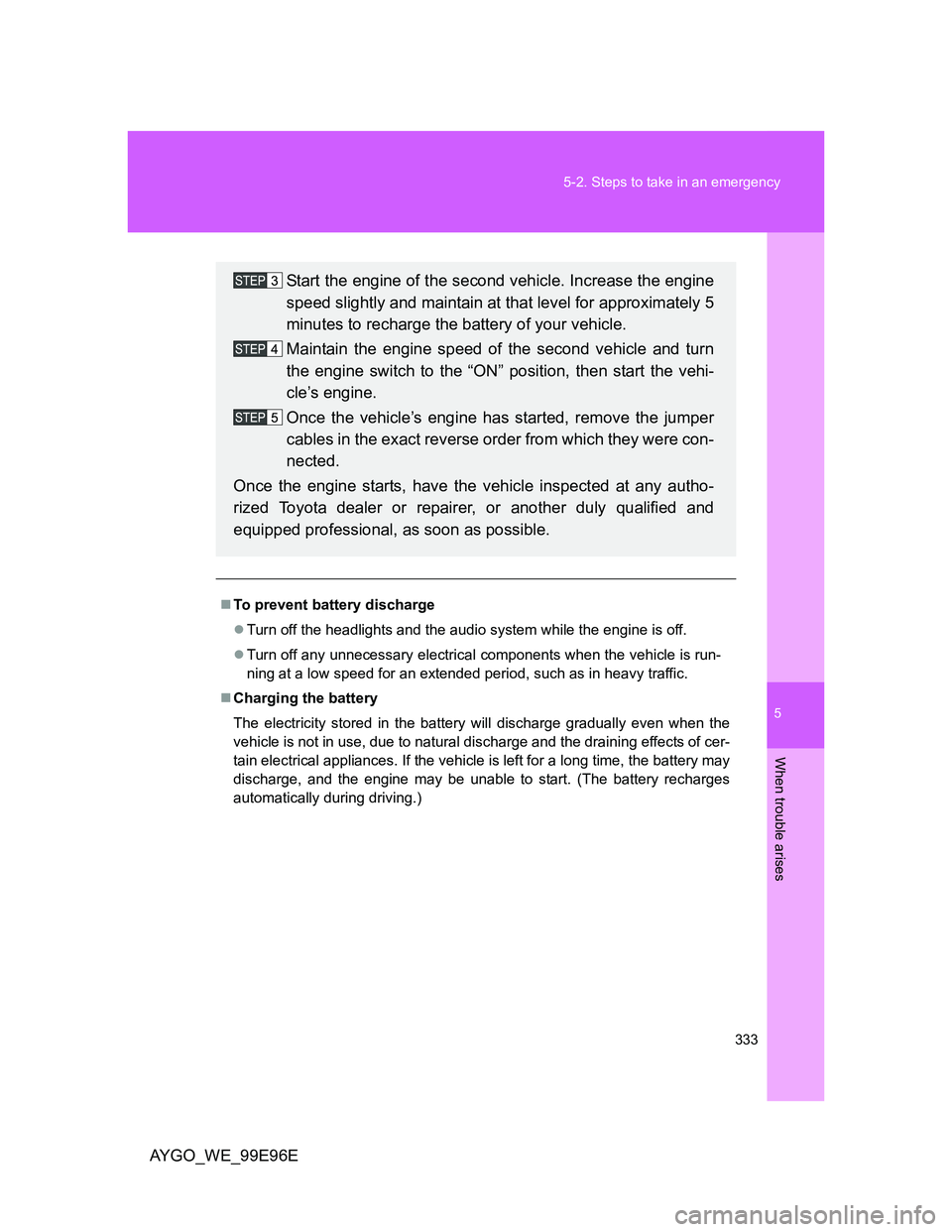
5
333 5-2. Steps to take in an emergency
When trouble arises
AYGO_WE_99E96E
To prevent battery discharge
Turn off the headlights and the audio system while the engine is off.
Turn off any unnecessary electrical components when the vehicle is run-
ning at a low speed for an extended period, such as in heavy traffic.
Charging the battery
The electricity stored in the battery will discharge gradually even when the
vehicle is not in use, due to natural discharge and the draining effects of cer-
tain electrical appliances. If the vehicle is left for a long time, the battery may
discharge, and the engine may be unable to start. (The battery recharges
automatically during driving.)
Start the engine of the second vehicle. Increase the engine
speed slightly and maintain at that level for approximately 5
minutes to recharge the battery of your vehicle.
Maintain the engine speed of the second vehicle and turn
the engine switch to the “ON” position, then start the vehi-
cle’s engine.
Once the vehicle’s engine has started, remove the jumper
cables in the exact reverse order from which they were con-
nected.
Once the engine starts, have the vehicle inspected at any autho-
rized Toyota dealer or repairer, or another duly qualified and
equipped professional, as soon as possible.
Page 334 of 368

334 5-2. Steps to take in an emergency
AYGO_WE_99E96E
CAUTION
Avoiding battery fires or explosions
Observe the following precautions to prevent accidentally igniting the flam-
mable gas that may be emitted from the battery:
Make sure each jumper cable is connected to the correct terminal and that
it is not unintentionally in contact with any other than the intended terminal.
Do not allow the + and - clamps of the jumper cables to come into contact
with each other.
Do not smoke, use matches, cigarette lighters or allow open flame near
the battery.
Battery precautions
The battery contains poisonous and corrosive acidic electrolyte, while
related parts contain lead and lead compounds. Observe the following pre-
cautions when handling the battery:
When working with the battery, always wear safety glasses and take care
not to allow any battery fluids (acid) to come into contact with skin, clothing
or the vehicle body.
Do not lean over the battery.
In the event that battery fluid comes into contact with the skin or eyes,
immediately wash the affected area with water and seek medical attention.
Place a wet sponge or cloth over the affected area until medical attention
can be received.
Always wash your hands after handling the battery support, terminals, and
other battery-related parts.
Do not allow children near the battery.
To prevent damage to the vehicle
Do not pull- or push-start the vehicle as the three-way catalytic converter
may overheat and become a fire hazard.
Page 336 of 368
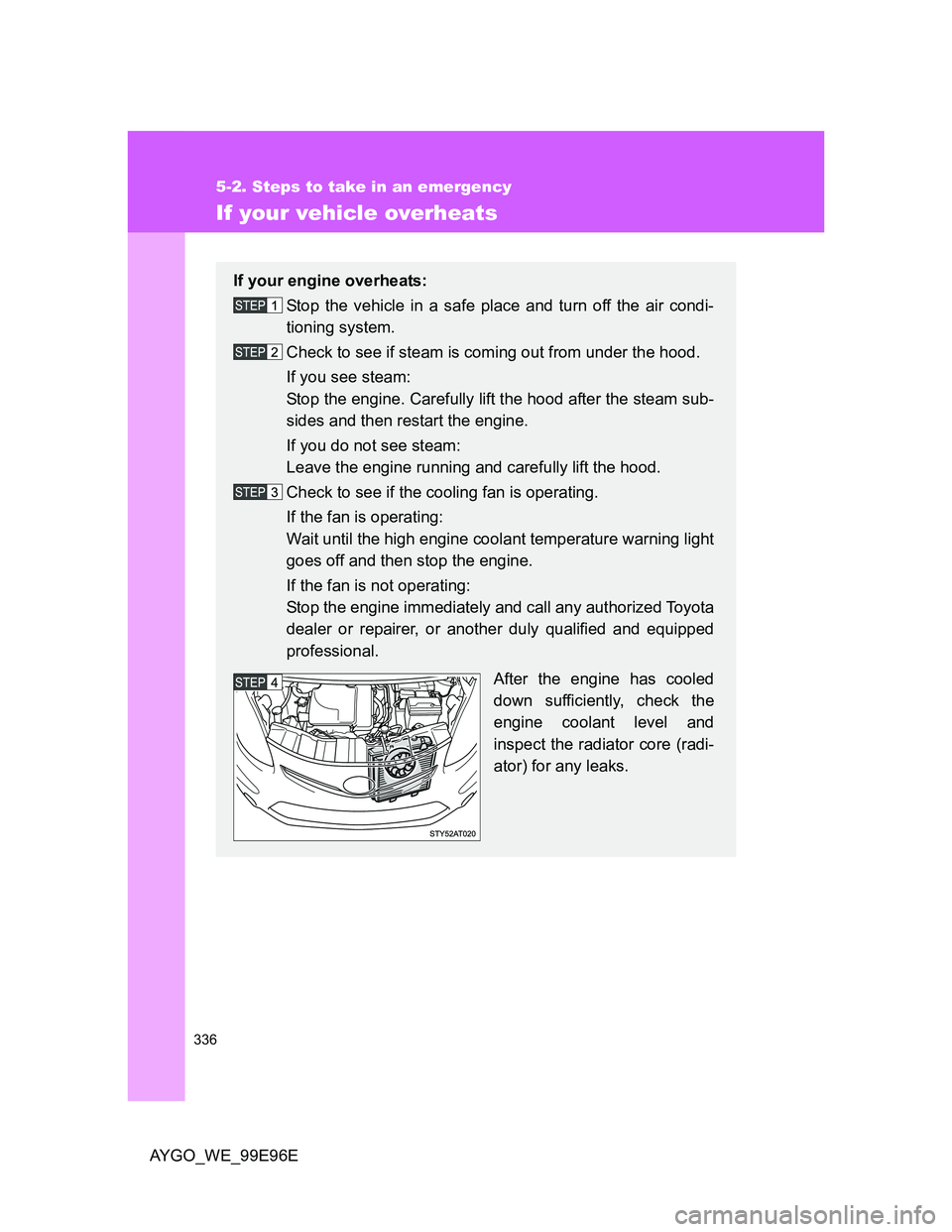
336
5-2. Steps to take in an emergency
AYGO_WE_99E96E
If your vehicle overheats
If your engine overheats:
Stop the vehicle in a safe place and turn off the air condi-
tioning system.
Check to see if steam is coming out from under the hood.
If you see steam:
Stop the engine. Carefully lift the hood after the steam sub-
sides and then restart the engine.
If you do not see steam:
Leave the engine running and carefully lift the hood.
Check to see if the cooling fan is operating.
If the fan is operating:
Wait until the high engine coolant temperature warning light
goes off and then stop the engine.
If the fan is not operating:
Stop the engine immediately and call any authorized Toyota
dealer or repairer, or another duly qualified and equipped
professional.
After the engine has cooled
down sufficiently, check the
engine coolant level and
inspect the radiator core (radi-
ator) for any leaks.
Page 337 of 368
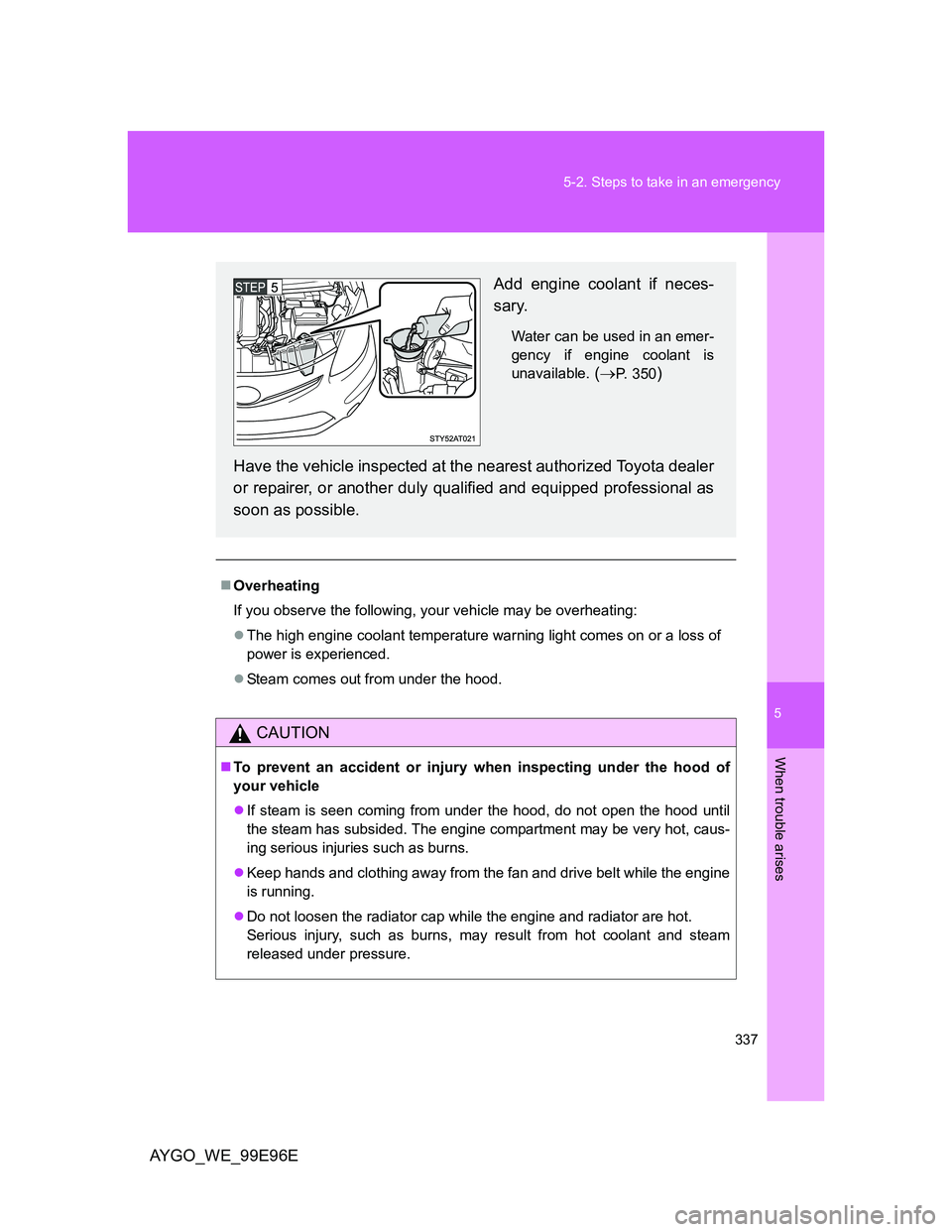
5
337 5-2. Steps to take in an emergency
When trouble arises
AYGO_WE_99E96E
Overheating
If you observe the following, your vehicle may be overheating:
The high engine coolant temperature warning light comes on or a loss of
power is experienced.
Steam comes out from under the hood.
CAUTION
To prevent an accident or injury when inspecting under the hood of
your vehicle
If steam is seen coming from under the hood, do not open the hood until
the steam has subsided. The engine compartment may be very hot, caus-
ing serious injuries such as burns.
Keep hands and clothing away from the fan and drive belt while the engine
is running.
Do not loosen the radiator cap while the engine and radiator are hot.
Serious injury, such as burns, may result from hot coolant and steam
released under pressure.
Add engine coolant if neces-
sary.
Water can be used in an emer-
gency if engine coolant is
unavailable.
(P. 350)
Have the vehicle inspected at the nearest authorized Toyota dealer
or repairer, or another duly qualified and equipped professional as
soon as possible.